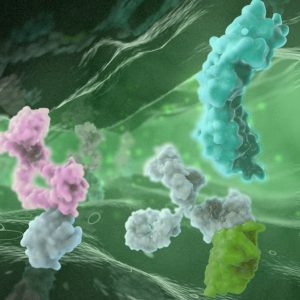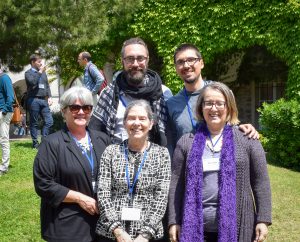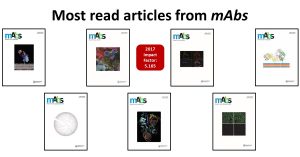
Most read from mAbs, October 2019
The Antibody Society is pleased to be affiliated with mAbs, a multi-disciplinary journal dedicated to advancing the art and science of antibody research and development. We hope you enjoy these summaries based on the abstracts of the most read papers published in a recent issue.
All the articles are open access; PDFs can be freely downloaded by following the links below.
Issue 11.7 (Oct 2019)
Glycoform-resolved FcɣRIIIa affinity chromatography–mass spectrometry
Lippold et al. describe a method to determination the impact of individual antibody glycoforms on FcɣRIIIa affinity, and consequently antibody-dependent cell-mediated cytotoxicity (ADCC) without performing high purity glycoengineering. They hyphenated FcɣRIIIa affinity chromatography to mass spectrometry, which allowed direct affinity comparison of glycoforms of intact monoclonal antibodies. The approach enabled reproduction and refinement of known glycosylation effects, and insights on afucosylation pairing as well as on low-abundant, unstudied glycoforms. Their method greatly improves the understanding of individual glycoform structure–function relationships, and it is highly relevant for assessing Fc-glycosylation critical quality attributes related to ADCC.
Looking for therapeutic antibodies in next-generation sequencing repositories
It is now possible to query the great diversity of natural antibody repertoires using next-generation sequencing (NGS) using methods capable of producing millions of sequences in a single experiment. In this new article, Krawczyk et al. compare clinical-stage therapeutic antibodies to the ~1b sequences from 60 independent sequencing studies in the Observed Antibody Space database, which includes antibody sequences from NGS analysis of immunoglobulin gene repertoires. Of 242 post-Phase 1 antibodies, they found 16 with sequence identity matches of 95% or better for both heavy and light chains. There were also 54 perfect matches to therapeutic CDR-H3 regions in the NGS outputs, suggesting a nontrivial amount of convergence between naturally observed sequences and those developed artificially. The authors discuss the potential implications for both the legal protection of commercial antibodies and the discovery of antibody therapeutics.
Elucidating heavy/light chain pairing preferences to facilitate the assembly of bispecific IgG in single cells
Joshi et al. report that a high yield (>65%) of bispecific IgG1 (BsIgG1) without Fab engineering can be a surprisingly common occurrence, i.e., observed for 33 of the 99 different antibody pairs evaluated. Installing charge mutations at both CH1/CL interfaces was sufficient for near quantitative yield (>90%) of BsIgG1 for most (9 of 11) antibody pairs tested with this inherent cognate chain pairing preference. Mechanistically, they demonstrate that a strong cognate pairing preference in one Fab arm can be sufficient for high BsIgG1 yield. These observed chain pairing preferences are apparently driven by variable domain sequences and can result from a few specific residues in the complementarity-determining region (CDR) L3 and H3. Transfer of these CDR residues into other antibodies increased BsIgG1 yield in most cases. Mutational analysis revealed that the disulfide bond between heavy and light chains did not affect the yield of BsIgG1. This study provides some mechanistic understanding of factors contributing to antibody heavy/light chain pairing preference and subsequently contributes to the efficient production of BsIgG in single host cells.
Antibody Fc engineering for enhanced neonatal Fc receptor binding and prolonged circulation half-life
The neonatal Fc receptor (FcRn) promotes antibody recycling through rescue from normal lysosomal degradation. The binding interaction is pH-dependent with high affinity at low pH, but not under physiological pH conditions. In this new article, Mackness et al. describe how they combined rational design and saturation mutagenesis to generate novel antibody variants with prolonged half-life and acceptable development profiles. First, a panel of saturation point mutations was created at 11 key FcRn-interacting sites on the Fc region of an antibody. Multiple variants with slower FcRn dissociation kinetics than the wildtype (WT) antibody at pH 6.0 were successfully identified. The mutations were further combined and characterized for pH-dependent FcRn binding properties, thermal stability and the FcγRIIIa and rheumatoid factor binding. The most promising variants, YD (M252Y/T256D), DQ (T256D/T307Q) and DW (T256D/T307W), exhibited significantly improved binding to FcRn at pH 6.0 and retained similar binding properties as WT at pH 7.4. The pharmacokinetics in human FcRn transgenic mice and cynomolgus monkeys demonstrated that these properties translated to significantly prolonged plasma elimination half-life compared to the WT control. The novel variants exhibited thermal stability and binding to FcγRIIIa in the range comparable to clinically validated YTE and LS variants, and showed no enhanced binding to rheumatoid factor compared to the WT control. These engineered Fc mutants are promising new variants that are widely applicable to therapeutic antibodies, to extend their circulation half-life with obvious benefits of increased efficacy, and reduced dose and administration frequency.
Like this post but not a member? Please join!
AIRR Community Meeting V: “Exploring New Frontiers”
Most read from mAbs, July 2019
The Antibody Society is pleased to be affiliated with mAbs, a multi-disciplinary journal dedicated to advancing the art and science of antibody research and development. We hope you enjoy these summaries based on the abstracts of the most read papers published in a recent issue.
All the articles are open access; PDFs can be freely downloaded by following the links below.
Issue 11.5 (July 2019)
In this Perspective article, Vasquez et al. examine data in two publications from the same research laboratory that report on structure-based in silico design of antibodies against viral targets without sequence disclosure, and find that the antibodies align with high sequence identity to previously reported antibodies of the same specificity. They note that the lack of reproducible computational algorithms and output sequences in the initial publications obscures the relationship to previously reported antibodies, and sows doubt as to the genesis narrative described in the publications.
In their companion Perspective article, De novo discovery of antibody drugs – great promise demands scrutiny, mAbs’ Assistant Editors Jonny Finlay and Alex Lugovskoy discuss the real-world issues and the concerns raised by Vásquez et al., which suggest much more work is needed to realize the bold vision of delivering in silico designed antibody therapies to patients.
Bivi et al. used anti-drug antibody (ADA) assays to detect and measure pre-existing reactivity or the ability of a molecule to produce an ADA-like response in serum from treatment-naïve, healthy donors. They report that the magnitude of pre-existing reactivity evaluated pre-clinically and expressed as the 90th percentile of Tier 2 inhibition correlates with the subsequent rate of ADA emergence in the clinic. Using the components of an IgG-scFv bispecific antibody in the Tier 2 step of the ADA assay, they identified the scFv as the target of the serum pre-existing reactivity. Most importantly, the domain specificity of pre-existing ADA was the same as that of the treatment-emergent-ADA from patients treated with the molecule. Based on these data, they propose the evaluation of the magnitude and of the domain specificity of pre-existing reactivity as a powerful tool to understand the immunogenic potential of novel biotherapeutics.
In this new report, Asensio et al immunized mice that transgenically express human antibodies with either programmed cell death 1 protein or cytotoxic T-lymphocyte associated protein 4 using four different immunization protocols, and then utilized a single cell microfluidic platform to generate tissue-specific, natively paired immunoglobulin (Ig) repertoires from each method and enriched for target-specific binders using yeast single-chain variable fragment display. The data suggest that, although different immunization protocols may generate a response to an antigen, performing multiple immunization protocols in parallel can yield greater Ig diversity. They conclude that modern microfluidic methods, followed by an extensive molecular genomic analysis of antibody repertoires, can be used to quickly analyze new immunization protocols or mouse platforms.
Parthiban et al report on use of their mammalian cell libraries of up to 10 million clones displaying a repertoire of IgG-formatted antibodies on the cell surface. TALE nucleases or CRISPR/Cas9 were used to direct the integration of the antibody genes into a single genomic locus, thereby rapidly achieving stable expression and transcriptional normalization. The authors used the system to affinity mature a PD-1-blocking antibody through the systematic mutation and functional survey of 4-mer variants within a 16 amino acid paratope region. Mutating VH CDR3 only, they identified a dominant “solution” involving substitution of a central tyrosine to histidine, but this variant was surpassed by a lysine substitution when light chain variants were introduced. This comprehensive and quantitative interrogation of sequence space was achieved by combining high-throughput oligonucleotide synthesis with mammalian display and flow cytometry operating at the multi-million scale.
Ellwanger et al. report on the redirected optimized cell killing (ROCK®) antibody platform, which comprises a plethora of CD16A-binding innate immune cell engagers with unique properties. In particular, they discuss the advantages of innate immune cell engagement over classical monoclonal antibodies and other engager concepts, and present details on its potential to engineer a fit-for-purpose innate immune cell engager format that can be equipped with unique CD16A domains, modules that influence pharmacokinetic properties and molecular architectures that influence the activation of immune effectors, as well as tumor targeting.




